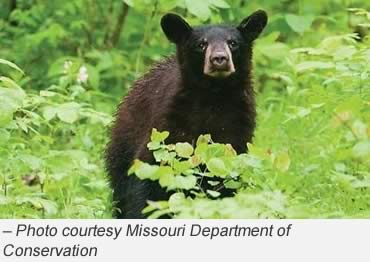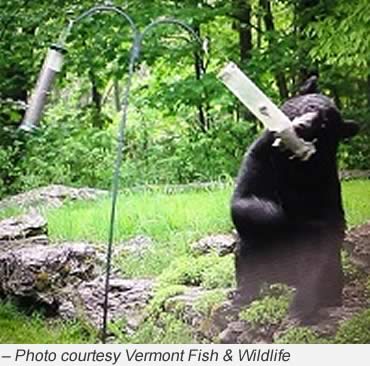Longer daylight hours, warming temperatures and green, growing plants mean black bears are moving from Vermont and Michigan to Missouri and west to Montana, and all the states between.
And all those bears are looking for the same thing: Food.
“As black bears become active in the spring, they are on a mission to find food,” said Laura Conlee, a resource scientist and black-bear researcher with the Missouri Department of Conservation.
Black bears attract a lot of attention when they are spotted. Unfortunately, during spring, many of the calls received by state Conservation or Natural Resources offices involve problems with bears visiting places where they are not wanted.
“Everyone has a different point when they are going to pick up the phone and call us,” according to Katie Keen, wildlife communications coordinator with the Michigan Department of Natural Resources. “The majority of calls we receive about bears involve a bird feeder that has been visited multiple times. Taking the feeder down before it’s found by a bear can eliminate future problems. A bear doesn’t forget a free meal.”
 In Montana, where both black bears and grizzly bears emerge from hibernation at the same time, bears move to lower elevations for the spring green-up and look for food along the way.
In Montana, where both black bears and grizzly bears emerge from hibernation at the same time, bears move to lower elevations for the spring green-up and look for food along the way.
It takes a few weeks for the bear’s digestive system to return to normal, biologists in Montana say. The bear has been in the den 4 to 5 months without eating, defecating or urinating; the stomach and digestive system is empty, so the bear starts out eating dry grass or roughage to activate its digestive system.
It’s simple. Bears are attracted to anything that smells like food, which means the first, important thing for humans to know is to never intentionally feed a bear.
Often, humans unintentionally feed bears by being unaware that the dog food they left in a bowl by the back door, or the bird feeder they just filled or the grill where they recently barbecued some chicken is exactly what has attracted a bear.
Knowing what attracts bears is the definition for being bear aware.
“Feeding bears makes them comfortable around people, which also makes them dangerous,” Conlee explains.
“When bears lose their fear of people, they approach people in search of food or may defend the food source or territory they associate with people,” she said. “When this happens, a bear has to be destroyed. A fed bear is a dead bear.”
Bears also have excellent memories.
“Bears will often return year after year to places where they were provided food,” Conlee said, even if the food was provided unintentionally.
 There are some simple steps that can be taken to avoid negative bear interactions.
There are some simple steps that can be taken to avoid negative bear interactions.
One of the easiest things to do is to remove all bird feeders from April to November where bears are active. Bird seed and suet are especially attractive and the scent draws bears from their natural habitat where they would normally be eating the roots of early spring plants and insect larvae.
“Bears that receive a food reward when around homes, yards and neighborhoods typically lose their natural fear of humans,” Keen explained. “If a bear walks through your property and no food reward is given, the bear will move along on its own.”
The Vermont Fish & Wildlife Department also advises that seed, suet and especially black oil sunflower seed feeders should be permanently removed and the area cleaned of spilled seed. Bears will still be attracted to any area where seed spilled on the ground.
States as far apart as Vermont and Montana have similar rules on feeding bears.
In Montana, it’s illegal to intentionally feed bears, mountain lions and ungulates (animals with hooves). This includes putting out grain, deer blocks, mineral blocks, sunflower seeds, garbage, meat scraps, bread, donuts, brownies and other food.
Vermonters are advised to take reasonable measures to protect their property from bears by keeping chickens and honeybees secure behind electric fences or other bear-proof enclosures, and to store trash in a secure place. Electric fences are also advised for similar reasons in Montana and Michigan.
The most common sources of food that attract bears are pet food, bird feeders, barbecue grills, garbage, trash containers, open dumpsters, campsites with accessible food and food wastes.
Missouri’s Department of Conservation also advises hikers to avoid close encounters with bears by making noise while walking or hiking to prevent surprising a bear. Clap, sing or talk loudly or travel in a group. Pay attention to your surroundings and watch for bear sign.
For more advice from wildlife managers, here are some good places for information:
From Vermont: click here
From Michigan: click here
And check out the “Bear Essentials” video by clicking here.
From Missouri: click here
And from Montana Fish, Wildlife & Parks, find information on bear-proof containers and electric fencing by clicking here.
— Read recent Critter Tale:
Unwelcome guests or feathered friends?